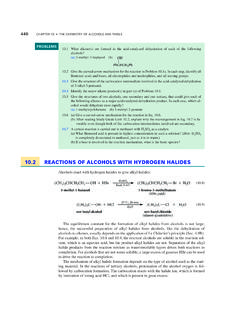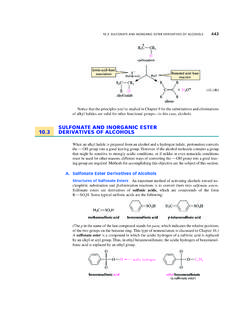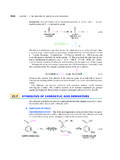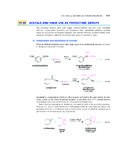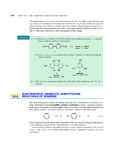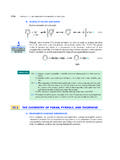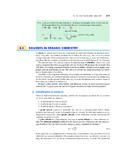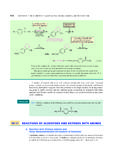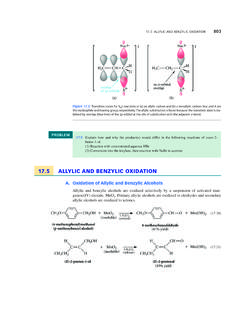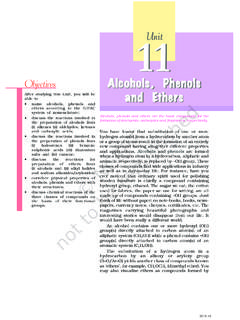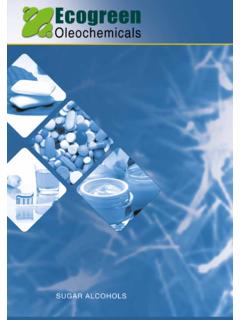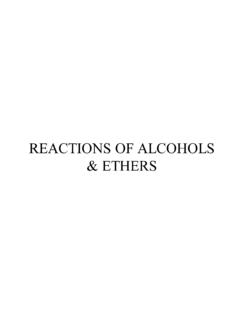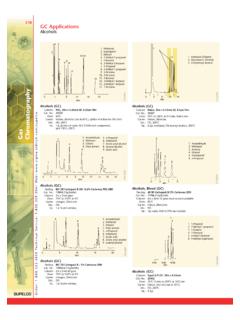Transcription of 8.6 ACIDITY OF ALCOHOLS AND THIOLS - …
1 ACIDITY OF ALCOHOLS AND THIOLS355ural barrier to the passage of ions. However, the hydrocarbon surface of nonactin allows it toenter readily into, and pass through, membranes. Because nonactin binds and thus transportsions, the ion balance crucial to proper cell function is upset, and the cell ChannelsIon channels, or ion gates, provide passageways for ions into and out ofcells. (Recall that ions are not soluble in membrane phospholipids.) The flow of ions is essen-tial for the transmission of nerve impulses and for other biological processes. A typical chan-nel is a large protein molecule imbedded in a cell membrane. Through various mechanisms,ion channels can be opened or closed to regulate the concentration of ions in the interior of thecell. Ions do not diffuse passively through an open channel; rather, an open channel containsregions that bind a specific ion. Such an ion is bound specifically within the channel at oneside of the membrane and is somehow expelled from the channel on the other side.
2 Remark-ably, the structures of the ion-binding regions of these channels have much in common withthe structures of ionophores such as nonactin. The first X-ray crystal structure of a potassium-ion channel was determined in 1998 by a team of scientists at Rockefeller University led byProf. Roderick MacKinnon (b. 1956), who shared the 2003 Nobel Prize in Chemistry for thiswork. The interior of the channel contains binding sites for two potassium ions; these sites areoxygen-rich, much like the interior of nonactin. The oxygens in each site are situated so thatthey just fit a potassium ion and are too far apart to interact effectively with a sodium exterior of the channel molecule contains many groups that solubilize or anchor itwithin the phospholipid bilayer of the cell membrane. When two potassium ions bind into thechannel, the repulsion between the two ions balances the ion-binding forces, and one of theions can then leave the channel; this is postulated to be the mechanism of ionic OF ALCOHOLS AND THIOLSA lcohols and THIOLS are weak acids.
3 In view of the similarity between the structures of waterand ALCOHOLS , it may come as no surprise that their acidities are about the conjugate bases of ALCOHOLS are generally called alkoxides. The common name of analkoxide is constructed by deleting the final ylfrom the name of the alkyl group and addingthe suffix oxide. In substitutive nomenclature, the suffix ateis simply added to the name of relative acidities of ALCOHOLS and THIOLS are a reflection of the element effectdescribedin Sec. THIOLS , with pKavalues near 10, are substantially more acidic than ALCOHOLS . Forexample, the pKaof ethanethiol, CH3CH2SH, is |common:substitutive:sodium ethoxidesodium ethanolate_CH3CH2O322%% crown ether [18]-crown-6 (structure on p. 352) has a strong affinity for the methylammo-nium ion, CH3|NH3. Propose a structure for the complex between [18]-crown-6 and this ion.(Although the crown ether is bowl-shaped, you can draw a planar structure for purposes ofthis problem.)
4 Show the important interactions between the crown ether and the 12/8/08 11:05 AM Page 355356 CHAPTER 8 INTRODUCTION TO ALKYL HALIDES, ALCOHOLS , ETHERS, THIOLS , AND SULFIDESThe conjugate bases of THIOLS are called mercaptidesin common nomenclature and thio-latesin substitutive Formation of Alkoxides and MercaptidesBecause the ACIDITY of a typical alcohol is about the same as that of water, an alcohol cannotbe converted completely into its alkoxide conjugate base in an aqueous NaOH solution.( )Because the relative pKavalues are nearly the same for ethanol and water, both sides of theequation contribute significantly at equilibrium. In other words, hydroxide is not a strongenough base to convert an alcohol completely into its conjugate-base can be formed irreversibly from ALCOHOLS with stronger bases. One convenient baseused for this purpose is sodium hydride, NaH, which is a source of the hydride ion,H3_.
5 Hydrideion is a very strong base; the pKaof its conjugate acid, H2, is about 37. Hence, its reactions withalcohols go essentially to completion. In addition, when NaH reacts with an alcohol, the reactioncannot be reversed because the by-product, hydrogen gas, simply bubbles out of the solution.( )Potassium hydride and sodium hydride are supplied as dispersions in mineral oil to protect them fromreaction with moisture. When these compounds are used to convert an alcohol into an alkoxide, themineral oil is rinsed away with pentane, a solvent such as ether or THF is added, and the alcohol isintroduced cautiously with stirring. Hydrogen is evolved vigorously and a solution or suspension ofthe pure potassium or sodium alkoxide is of alkoxides in their conjugate-acid ALCOHOLS find wide use in organic reaction used to prepare such solutions is analogous to a reaction of water you may haveobserved.
6 Sodium reacts with water to give an aqueous sodium hydroxide solution:( )The analogous reaction occurs with many ALCOHOLS . Thus, sodium metal reacts with an alcoholto afford a solution of the corresponding sodium alkoxide:( )+NaLR2222OH+sodium alkoxide2 Na|_322 ORH21+NaLH22 222 OHNa|+_322 OHH21+Na|_3 HCHCH2CH3CH3 LLH22O"+quantitative yieldNa|_3 CHCH2CH3CH3L22O"H21++22OH_3_CH3CH2O322L2 2CH3CH2 OHpKa = = Give the structure of each of the following compounds.(a)sodium isopropoxide (b) potassium tert-butoxide(c)magnesium 2, Name the following compounds.(a)Ca(OCH3)2(b) CuLSCH2CH3 PROBLEMSNa|common:substitutive:sodium methyl mercaptidesodium 12/8/08 11:05 AM Page ACIDITY OF ALCOHOLS AND THIOLS357 The rate of this reaction depends strongly on the alcohol. The reactions of sodium with anhy-drous (water-free) ethanol and methanol are vigorous, but not violent. However, the reactionsof sodium with some ALCOHOLS , such as tert-butyl alcohol, are rather slow.
7 The alkoxides ofsuch ALCOHOLS can be formed more rapidly with the more reactive potassium THIOLS are much more acidic than water or ALCOHOLS , they, unlike ALCOHOLS , can beconverted completely into their conjugate-base mercaptide anions by reaction with oneequivalent of hydroxide or alkoxide. In fact, a common method of forming alkali-metalmercaptides is to dissolve them in ethanol containing one equivalent of sodium ethoxide:( )Because the equilibrium constant for this reaction is >105(Sec. ), the reaction goes es-sentially to alkali-metal mercaptides are soluble in water and ALCOHOLS , THIOLS form insolublemercaptides with many heavy-metal ions, such as Hg2+, Cu2+, and Pb2+.( )( )The insolubility of heavy-metal mercaptides is analogous to the insolubility of heavy-metalsulfides (for example, lead(II) sulfide, PbS), which are among the most insoluble inorganiccompounds known.
8 One reason for the toxicity of lead salts is that the lead forms very strong(stable) mercaptide complexes with the thiol groups of important a Disease with MercaptidesA relatively rare inherited disease of copper metabolism, Wilson s disease, can be treated by using thetendency of THIOLS to form complexes with copper ions. Accumulation of toxic levels of copper in thebrain and liver causes the disease. Penicillamine is administered to form a complex with the Cu2|ions:The penicillamine-copper complex, unlike ordinary cupric thiolates, is relatively soluble in water be-cause of the ionized carboxylic acid groups, and its solubility allows it to be excreted by the of two penicillamine moleculeswith Cu+2 SHCHCNH3 OOS(CH3)2 CCHCuOCOS ionizedcarboxylic acidionizedcarboxylic acidSSLLLLC(CH3)2H2 NCHCNH2 OOS(CH3) +HgCl22 PhSH(PhS)2Hg(98% yield)HCl2++PbCl2decanethiolLCH3(CH2)92S H[CH3(CH2)9S]2 Pblead(II) decanethiolate(87% yield)HCl2+C2H5OH+22C2H5 SHethanethiolpKa = ion22C2H5O_3+ethanolpKa = 12/8/08 11:05 AM Page 357358 CHAPTER 8 INTRODUCTION TO ALKYL HALIDES, ALCOHOLS , ETHERS, THIOLS , AND SULFIDESB.
9 Polar Effects on Alcohol AciditySubstituted ALCOHOLS and THIOLS show the same type of polar effect on ACIDITY as do substitutedcarboxylic acids (Sec. ). For example, ALCOHOLS containing electronegative substituentgroups have enhanced ACIDITY . Thus, 2,2,2-trifluoroethanol is more than three pKaunits moreacidic than ethanol ACIDITY :( )The polar effects of electronegative groups are more important when the groups are closer tothe LOH group:Relative ACIDITY :( )Notice that the fluorines have a negligible effect on ACIDITY when they are separated from theLOH group by four or more Role of the Solvent in Alcohol AcidityPrimary, secondary, and tertiary ALCOHOLS differ significantly in ACIDITY ; some relevant pKaval-ues are shown in Table The data in this table show that the acidities of ALCOHOLS are in theorder methyl >primary >secondary >tertiary. For many years chemists thought that thisorder was due to some sort of polar effect (Sec.)
10 Of the alkyl groups around the alcoholoxygen. However, chemists were fascinated when they learned that in the gas phase in theabsence of solvent the order of ACIDITY of ALCOHOLS is exactly gas-phase ACIDITY :(CH3)3 COH>(CH3)2 CHOH>CH3CH2OH>CH3OH( ) In each of the following sets, arrange the compounds in order of increasing ACIDITY (decreasing pKa). Explain your choices.(a)ClCH2CH2OH, Cl2 CHCH2OH, Cl(CH2)3OH(b) ClCH2CH2SH, ClCH2CH2OH, CH3CH2OH(c)CH3CH2CH2CH2OH, CH3 OCH2CH2 OHPROBLEMLLF3 CCH2 LCH2 LCH2 OHLLF3 CCH2 LCH2 OHLLF3 CCH2OH<< < of ALCOHOLS in Aqueous (CH3) (CH3) 12/8/08 11:05 AM Page BASICITY OF ALCOHOLS AND ETHERS359 Notice carefully what is being stated here. The relative order of ACIDITY of different typesof ALCOHOLS is reversed in the gas phase compared with the relative orderof ACIDITY in is nottrue that ALCOHOLS are more acidic in the gas phase than they are in solution; rather, allalcohols are muchmore acidic in solution than they are in the gas ALCOHOLS are more acidic than unbranched ones in the gas phasebecause a-alkylsubstituents stabilize alkoxide ions more effectively than hydrogens.
